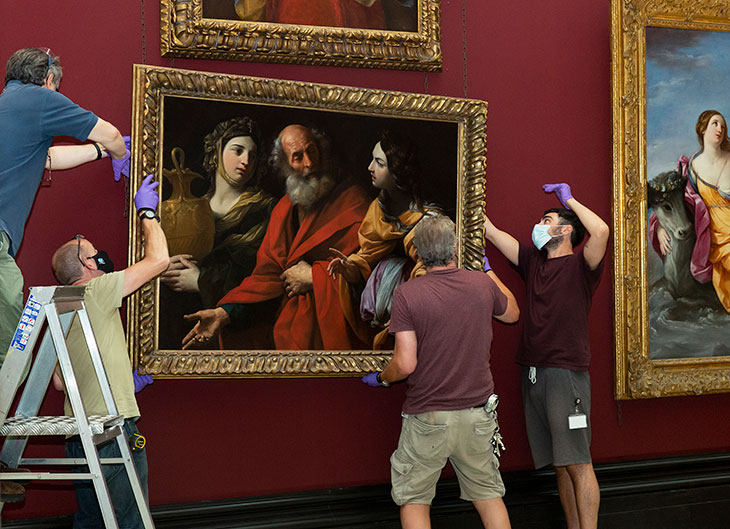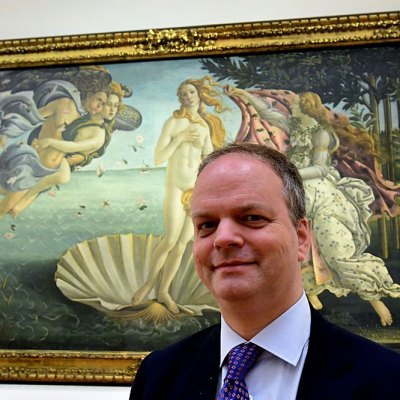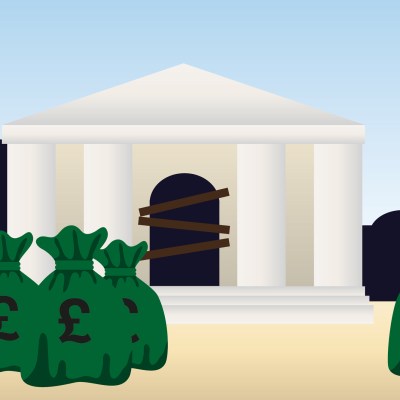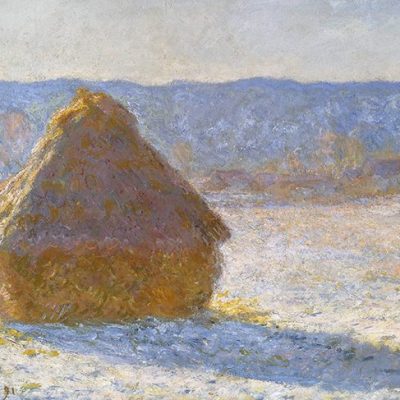Gabriele Finaldi, director of the National Gallery, London, talks to Thomas Marks about reopening the museum and how it is rethinking its relationship with its audience
How challenging has it been to lead the National Gallery while its doors have been closed for more than three months?
In some ways it’s been straightforward. We have a very professional and focused workforce, and all of us adapted quickly to working from home and using online communication facilities. It is very strange trying to direct a museum that’s not actually open, though: usually a huge proportion of your work is about ensuring that everything is functioning properly; when you’re no longer open, you turn to look at what the future holds financially, and at planning your activities and programmes.
Personally, I felt a great anxiety to be back in the gallery after a period of self-isolating. Having grown up with it, and feeling very emotionally bound up with it, being away felt like a sort of exile. Returning brought the sheer excitement of seeing the pictures as physical objects once again, rather than as images on a telephone screen or laptop at home. To renew those physical connections with the works of art – to be able to approach them close up, to stand back, to look at them in different lights – was a very moving experience for me.
Has the period of closure offered you the opportunity to reflect on the mission of the National Gallery?
As the staff of the gallery, we think of ourselves very much as facilitators and mediators, enabling the encounter between the collections that we look after and the people who we serve – and we try to do that in lots of different ways, and be imaginative about it. We try to be committed to academic research but also to find ways for the collection to speak.
When your collection is in quarantine, you have to find different means to do that. Like so many museums we suddenly became an online gallery, and fortunately we were quite well prepared for that, I think, because we’ve invested strongly in our digital capabilities over the past few years and were able to make the switch relatively quickly. If there’s one thing that that I think we’ve all learnt during this period, it’s that digital is clearly an extremely valuable tool and means of communication – but it needs to be much more embedded in what we do.
Will the National Gallery look different when it reopens?
We thought we’d be able to do lots of work in the gallery while it was closed; in the event that hasn’t been as possible as we had hoped. Over the last month, however, as we’ve been preparing to reopen, quite a lot has been going on. I think when people come back, they’ll find a few surprises in the way that some of the collections are presented: there’ll be new pictures on show, and we’ve refurbished the largest room in the gallery [Room 32]. Ultimately it’s about sharing the pictures with the public; getting the collection ready to be shared again has been one of our absolute priorities.
Installing the refurbished Room 32. Photo: © The National Gallery, London

When it reopens, the National Gallery will have three routes that visitors can take around the collection. If you were a visitor and could only take one of those routes, which would you pick?
You can take all three – let there be no confusion about that! – and you will be allowed to linger. If I were to choose just one of the routes, though, I’d pick route B. That takes you through the pictures which I have a very special affection for, the 17th-century pictures, and also through the new Julia and Hans Rausing Room [Room 32], which is a fantastic set piece at the gallery. It’s difficult to describe how splendid that room now looks compared to what it was like when we closed it just over two years ago.
The programme of upcoming exhibitions has, by necessity, been shuffled around, most notably with ‘Raphael’ postponed until 2022. Do you envisage that the programme will be as busy in the future as it has been in recent years?
If anything the Covid-19 pandemic has accelerated our thinking about that. It’s becoming more complex to put on ambitious exhibitions – it’s certainly becoming more expensive – and many museums have been looking at rationalising their programmes, and potentially at longer runs for exhibitions. I would say that there will be fewer institutions that will be able to put on the really big shows, and there will be fewer of those exhibitions than there have been in the past.
It’s been pretty frantic for the last 20 years. Now is the moment to pause a little, I think, and to think about our audiences more carefully. We’re going to be dealing with a predominantly local audience, which will be a new experience for us; we need to think about what the connection is between the permanent collection, the exhibition programme, and our UK audience. That’s an attractive challenge to confront: we’re very keen to use the opportunity to establish a closer relationship with the UK population.
Room 32 after refurbishment. Photo: © The National Gallery, London

To what extent have the National Gallery’s finances been dented by the period of closure?
We set out as an ambition, just over two years ago, to be 50 per cent self-financing, and aimed to do that by 2022/23. This is the first year in which we’ve managed it, and I think it’s probably going to be the last for some time. The model that we operate at the National Gallery, and that operates in the other national museums, is that we’re required to raise a substantial portion of our funding. That’s dependent on large numbers of people coming through the building. We make our self-generated revenue from our commercial activities – event hire, catering, and shops – but also from exhibition-ticketing income and development activity. In the context of a museum that’s shut, all of those revenue streams have pretty much dropped away, except for e-commerce, which has seen a light rise, and philanthropy, which I’m happy to say is holding – and we’re very grateful to our supporters for that.
The gallery will have been closed for three and a half months, more or less, by the time we reopen, but I’m certain that our numbers are going to take quite a while to build up. The gallery depends very heavily on tourists for the model to work – nearly 70 per cent of our visitors are tourists – and it will take some time before they start coming back at the previous volume. We need to think beyond this year, about the sustainability issues we’re going to encounter in 2021/22 and beyond. What I’m very convinced about is that the National Gallery, that museums, and that art and creativity have a very important part to play in the recovery and in the well-being of our country. That’s why all of us are trying very hard to get back to normal activity as quickly as we can. There was an additional responsibility on the shoulders of the National Gallery, I think, because we have a very strong history of doing that, particularly during the war years. In some ways it was quite significant for us to be among the first to reopen.
While many European governments have announced emergency funding packages for their respective culture sectors, the UK government has been accused of paying no more than lip service to the challenges currently facing the sector. Should the government be doing more to support museums financially at this point?
The first thing I’ll say is that we were all very impressed by how rapidly Arts Council England reacted to the situation, with so many people’s livelihoods are at risk. We’ve been talking a lot to our department, DCMS, we’ve been talking a lot to government and explaining just how serious the crisis is – and how big the demand is to resolve it.
At the same time we’ve been very impressed by how the Germans have responded, how the Italians have responded, how the French have responded. It’s not just a question of going with a begging bowl to government. We form part of a complex ecology, which is bound up with the economy, with tourism and with the well-being of the population. That’s been very well articulated to government, and I think that government understands. We’re now waiting to see what it’s going to do. I think we have a minister and a chancellor who are sensitive to the needs of the sector, but let’s see what the outcome is.
Room 36 following a rehang. Photo: © The National Gallery, London

During the period of closure, and in the context of international protests against racism, the National Gallery released a statement to express its ‘solidarity with those who reject racism, inequality and violence’. That statement included the declaration that the gallery needs to ‘listen, pose important questions and reflect on how our museum can play a role in making our society more just tolerant and inclusive’. How might the gallery start playing that role?
Traditionally museums have adopted a neutral position on the big political (with a small ‘p’) questions that people are very concerned about. That has become more difficult now. There is a lot of pressure on museums to take a stand. We’ve always been concerned to speak to as broad an audience as possible, to try to diversify our audiences and our own workforce. They are not easy things to do, and it’s probably true that we haven’t put enough resources into them.
The concerns that we’re experiencing in our society flow into the museum. We are thinking a lot now about how museums can address the big societal questions about education, social injustice, the environment, sexual equality, and how we can engage with them with our particular collections and programmes. We’re in London, which has a very diverse population but because our workforce is nowhere near as varied as that population, we don’t necessarily have the wherewithal to be able to reach out more broadly, which is one of our ambitions.
Another thing that appears in the statement is that we said that we have a particular, historically-rooted collection, and this is also very important to say. The collection is superb but it has a specific character; it reflects nearly 200 years of collecting, of tradition, of academic research and so on, and it is very important that we value that. But I think there are ways that we can talk about our collection which enable us to address bigger questions of inclusion, and of different histories.
For a period in June, the statue of George Washington that stands outside the National Gallery in Trafalgar Square [it is not part of the gallery’s collection] was boarded up to prevent its being damaged in protests. Are you aware of any works in the National Gallery that, whether due to their subject matter or provenance, might become the focus of protests or debates about the nature of the collection?
For us, it’s been a question of looking at the pictures that we have on the wall, and considering whether there was anything that we needed to highlight given the circumstances that we live in now. Things that in the past would perhaps have been of incidental interest have come to the fore, and we need to be sensitive to that. We have been doing some academic research on the legacy of slavery and it became clear in relation to certain British portraits, for example, that it was important to say on the label that this sitter was an anti-abolitionist or this other sitter’s wealth was based on plantations in the West Indies which had slave labour.
We haven’t removed anything from the walls; if anything, we want to talk about these things. One of the new initiatives that we began during lockdown is called ‘One painting, many voices’, it’s an online broadcast with a whole range of people talking about pictures like Gainsborough’s Mr and Mrs Andrews, or Holbein’s Ambassadors. It’s important that we don’t think of the collection as exclusively ours: it doesn’t belong only to professional art historians and curators, it’s a public collection and people have different approaches to it and different things to say about it. At the gallery we should welcome many voices speaking about our collection.
Besides the National Gallery, which museum are you most looking forward to revisiting when that becomes possible?
I’m desperately keen to visit Dulwich Picture Gallery, which is my local art gallery. And when we start travelling abroad, I’m very eager to go back to the Prado, where I used to work – I have family in Madrid as well, so it will be an opportunity to see them and see the great works in the collection.



